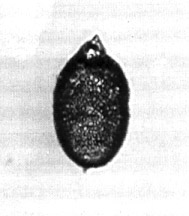 Lithopera
(Lithopera) neotera Sanfilippo and Riedel
Lithopera
(Lithopera) neotera Sanfilippo and Riedel Lithopera
(Lithopera) neotera Sanfilippo and Riedel
Lithopera
(Lithopera) neotera Sanfilippo and RiedelLithopera (Lithopera) neotera Sanfilippo and Riedel, 1970, p.454, pl.1, figs.24-26, 28
Subellipsoidal shell, of which the thorax forms the major part. Cephalis spherical, usually poreless, half or more of it sunken into the thorax, with a small apical horn. Collar structure generally not pronounced externally. From the base of the cephalis, primary lateral and dorsal spines extend in the thoracic wall or within the thoracic cavity to join the inner surface of the upper wall. Remainder of shell subellipsoidal with subregular pores not arranged in rows, and with practically no tendency to form a spongy meshwork in some specimens, a line in the shell wall (with no change in contour) distally separates a short, flattened area, which may be regarded as an abdomen, from the remainder, which may be regarded as the thorax (Sanfilippo and Riedel, 1970).
Based on 35 specimens. Total length 95-150 µm. Maximum breadth 75-130 µm (Sanfilippo and Riedel, 1970).
Closed postcephalic shell rather irregularly ellipsoidal, sometimes with a line in the shell wall (with no change in contour) demarcating an abdomen. Pores less regular than in L. bacca, and shell not spongy (Riedel and Sanfilippo, 1978a).
This species is distinguished form L. bacca by at least the major part of its shell wall being composed of irregularly spaced pores, and by its less regular contour. It differs from L. baueri Sanfilippo and Riedel (1970, p.455, pl.2, figs.1-2) in its smaller dimensions and in not having a spongy wall, and from L. renzae in not having a spongy wall and in its less pronounced third segment (Sanfilippo et al., 1985).
The shell is usually a two-segmented ellipsoid, but rare specimens show a line in the shell wall (with no change in contour) demarcating an abdomen. Early forms may have subdivided pores, reflecting the spongy character of the ancestor L. renzae. More commonly the pores are simple and irregularly arranged. In the upper part of the range, specimens transitional to L. bacca have some portion of shell wall in which the pores are very regular in arrangement (Sanfilippo et al., 1985).
L. neotera is found in all middle Miocene assemblages from latitudes lower than 40°. Its evolutionary transition from Lithopera renzae lies within the Dorcadospyris alata Zone and its evolutionary transition to Lithopera bacca lies within the Diartus petterssoni Zone.
L. neotera descended from L. renzae and is the ancestor of L. bacca.
Additional illustrations can be found in Riedel and Sanfilippo, 1971, pl.1F, figs.14-15, pl.2E, fig.19; 1978a, pl.6, fig.10.